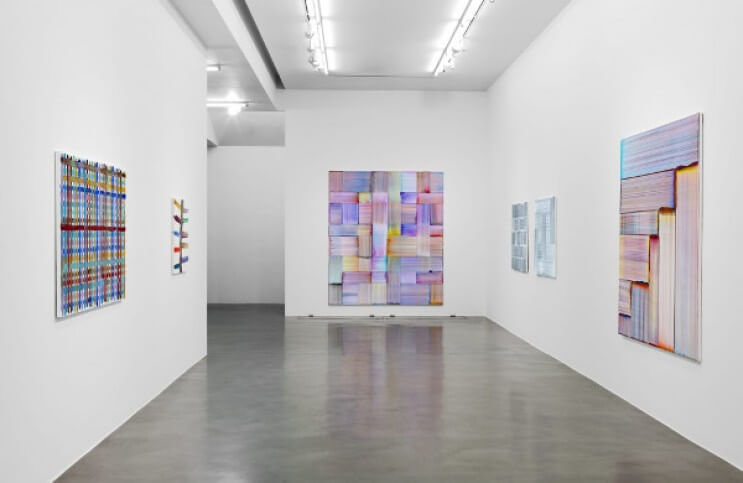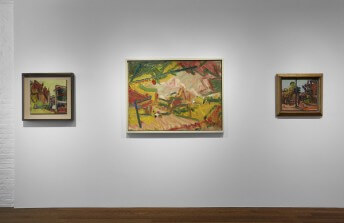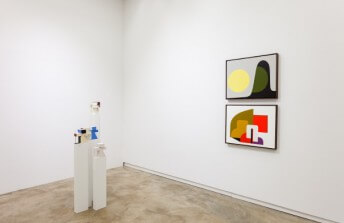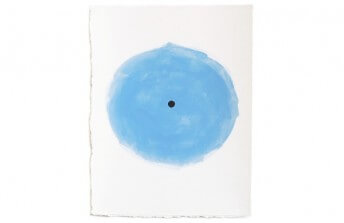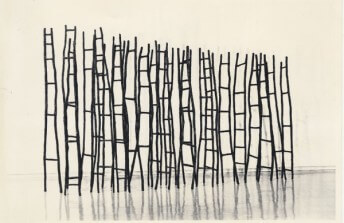The Interweaving Process of Bernard Frize
Jun 1, 2018
The George Pompidou Center in Paris will open a retrospective of the work of Bernard Frize in 2019. In anticipation of that exhibition, the Simon Lee Gallery in Mayfair, London, recently opened a tight little show examining one particular aspect of the oeuvre of this prolific abstract artist: his exploration of the grid as a structure for paintings. Titled Bernard Frize: Blackout in the Grid, this show brings together a current series by Frize with a grid-based series of paintings the artist made between the years 1999 and 2008. The two series are quite different visually, but their juxtaposition aptly demonstrates how Frize approaches his process. For those unfamiliar with Frize, he is sort of like a living manifestation of the idea Anni Albers expressed when she said, “Art work deals with the problem of a piece of art, but more, it teaches the process of all creating, the shaping out of the shapeless.” Throughout the four decades, Frize has never focused on the problems of any one particular painting. Instead, he has remained dedicated to demonstrating his own concept of what the process of creating looks like. His primary belief is that the artist should make as few decisions as possible. He sees the role of the creator as simply to develop systems under which art can essentially make itself. His method begins with him conceptualizing a structure for a series of paintings—for example, a grid. He then assigns a few additional rules to the structure, say for example that he is going to use a thin brush or a thick brush to apply the paint, or that the lines he is going to paint are going to be vertical or horizontal. Then he simply allows every conceivable variation within that structure to exhaust itself, at which point the series is complete and he moves on to another series, based on a new structure. As for what meaning his works have, Frize believes that is all up to the viewer, whose job it is to complete the work. Frize is not a poet. He sees artists as nothing more than technicians: workers whose job it is to use tools, processes, and paint, not to deal with the problem of any one particular piece of art, but to demonstrate to the world the utilitarian nature of all creation.
Expansion and Collapse
In one recent interview, Frize said everything he has ever done basically comes down to the processes of expansion and collapse. He expands a simple formula outward until it reaches its limit, never knowing ahead of time what that limit is going to be. Sometimes while working on a series, a formula gives rise to another formula, like the evolution of a new species. Other times the formula simply collapses upon itself without inspiring anything additional—the end of a creative line. His career could thus be seen as a celebration of how this process of expansion and collapse goes on infinitely, even as every individual structure or system inevitably reaches its physical and theoretical limits. It is a very philosophical approach to art, and even seems somewhat political in nature. Most artists embrace an authoritarian view that says they alone are in charge of making every creative choice. Frize, on the other hand, is expressing a vision of the creative process that is more ideological, in which each new series he creates adheres to laws that are inalterable, even by the artist.
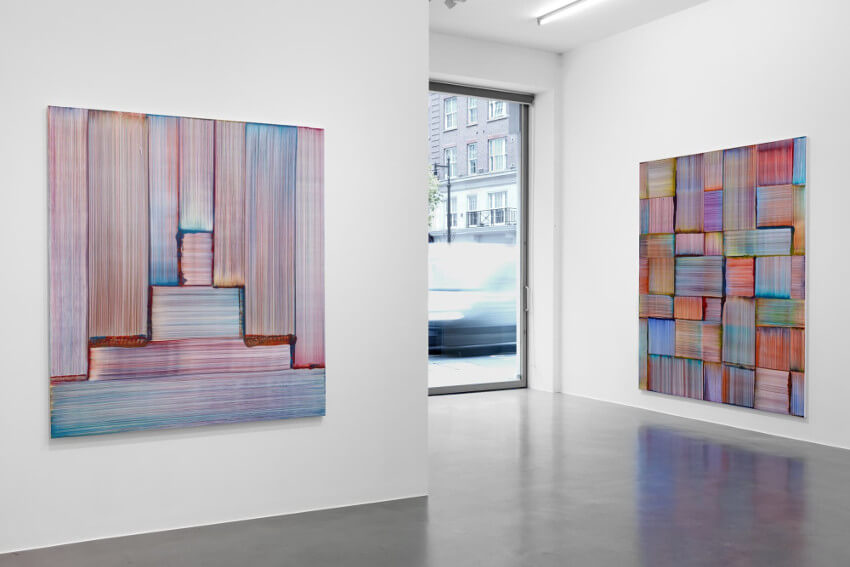
Bernard Frize: Blackout in the Grid, 2018, installation view, Simon Lee Gallery, London. Photo courtesy Simon Lee Gallery
It is almost as though Frize sees each of his series as a sort of individual culture, similar to human cultures, which each develop their own idiosyncratic personalities based on a few simple, fundamental distinguishing factors. This is how we recognize the subtle difference between French culture, German culture, Spanish culture, and so on. Each has a certain structure that was set up long ago, which determines what makes it unique from all other cultures. And so each series Fritz creates also develops along the same lines. Just as human cultures dissolve when their unique structures are subject to change based on the whims of each new generation, Frize realizes that he must take determination out of his process entirely so that each culture he develops will be allowed to fully embrace the idiosyncrasies that make it unique, without interference from the ego of the founder.
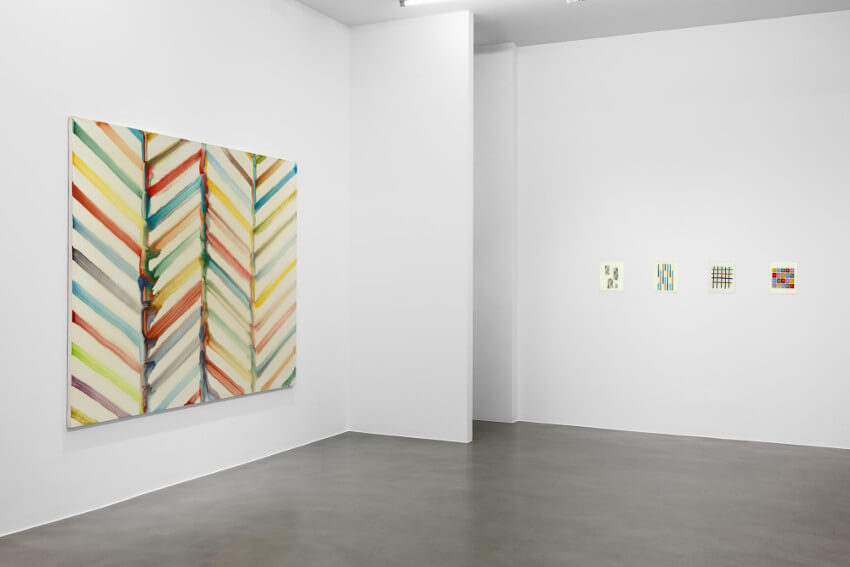
Bernard Frize: Blackout in the Grid, 2018, installation view, Simon Lee Gallery, London. Photo courtesy Simon Lee Gallery
On the Grid
Seen through the lens of politics and philosophy, the works on view in Blackout the Grid offer many fascinating insights for viewers. Despite their similarities, each of these paintings possesses clear and distinct differences that makes it unique. And yet also, despite those differences, each painting shares a clear and distinct foundation. No hierarchy of values has been expressed by the creator, which means no individual variation on the underlying structure is more true, or more pure, or more perfect than any other variation. The only inherently beautiful thing about any of the works in this exhibition is the structure on which all of the works are based.
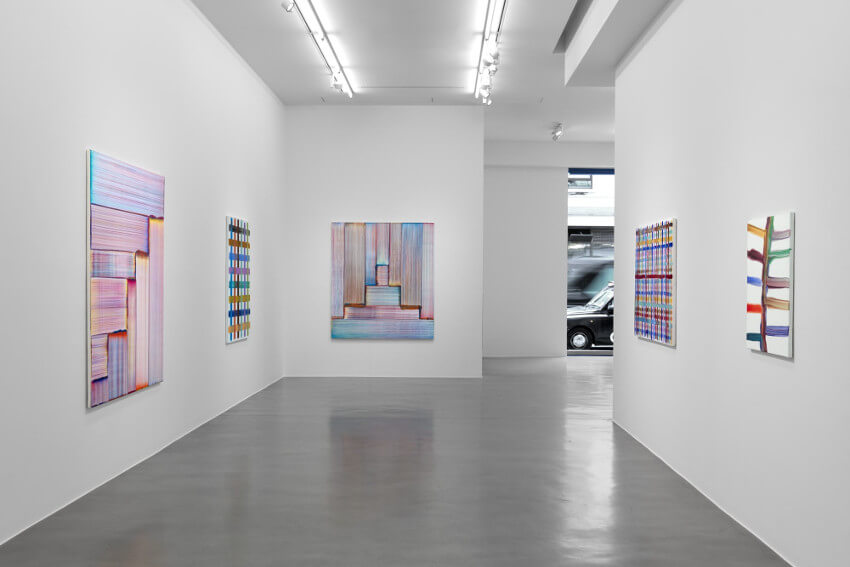
Bernard Frize: Blackout in the Grid, 2018, installation view, Simon Lee Gallery, London. Photo courtesy Simon Lee Gallery
Since Frize has left it entirely up to the viewers to find meaning in what he creates, one could take the liberty of noting that, as with his works, there is, within each human culture, an underlying structure that makes it similar to, yet distinct from, every other human culture. With his art, Frize has developed a philosophical basis on which to argue that every various expression of the underlying structure of human culture should be valued equally. None is “better” or “worse” or more beautiful or less beautiful than another. The grids that connect us are what matters. Their underlying structures are where our common values exist. That is where the potential for beauty exists—a profound lesson, even if Frize was in no way trying to teach anyone anything at all.
Featured image: Bernard Frize: Blackout in the Grid, 2018, installation view, Simon Lee Gallery, London. Photo courtesy Simon Lee Gallery
By Phillip Barcio
